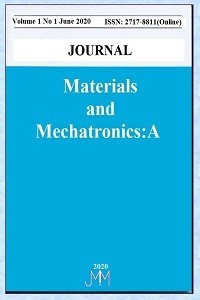Direnç Punta Kaynak Robotlarında KSR ve IQR (Adaptif Punta) Modun Spot Punta Performansının Karşılaştırılması
Punta kaynağı, Akım değeri, Punta çekirdek çapı, Kaynak zamanı
Comparison of Spot Tail Performance of KSR and IQR (Adaptive Tailstock) Mode in Resistance Spot Welding Robots
Spot welding, Current value, Spot core diameter, Welding time,
___
- Anastassiou M., Babit M., Lebrun J.L., Residual stress and microstructure distribution in spot welded steel sheets. Materials Science and Engineering: A 125, 141-156, 1990.
- Anonymous, Harms-Werde Product catalogue, www.harms-wende.de/(Erişim Tarihi: 16.10.2020)
- Babu S., Santella M., Feng Z., Riemer B., Cohron J., Empirical model of effects of pressure and temperature on electrical contact resistance of metals. Science and Technology of Welding and Joining 6(3), 126-132, 2001.
- Buchanan G., Resistance Welding Manual. Resistance Welder Manufacturers’ Alliance, Fourth Edition, Bridgeport, NJ., U.S., 2003.
- Cho Y., Kim Y., Rhee S., Development of a quality estimation model using multivariate analysis during resistance spot welding. Proceedings of the Institution of Mechanical Engineers Part B: Journal of Engineering Manufacture 215(11),1529-1538, 2001.
- Ho J.E., Wei P.S., Wu T.H., (2012). Workpiece Property Effect on Resistance Spot Welding. IEEE Transactions on Components, Packaging and Manufacturing Technology 2(6), 925-934, 2012.
- Quafi A.E., Belanger R., Méthot J.F., An On-line ANN-Based Approach for Quality Estimation in Resistance Spot Welding. Advanced Materials Research 112(1),141-148, 2010.
- Rawal M.R., Kolhapure R.R., Sutar S.S., Shinde V., Optimization of Resistance Spot Welding of 304 Steel Using GRA. International Journal of Computer Engineering in Research Trends 3(9), 492-499, 2016.
- Rui Y., Yang R.J., Chen C.J., Agrawal H., Fatigue optimization of spot welds. Body Design Engineering, IBEC, 96, 68-72, 1996.
- Saha D.C., Han S, Chin K.G., Choi I, Do Y.D., Weldability evaluation and microstructure analysis of resistance-spot- welded high-Mn steel in automotive application. Steel Research International 83(4), 352-357, 2012.
- Zhang H., Senkara J., Resistance welding: fundamentals and application, 1st Edition, Taylor & Francis Group, 105, 2006.
- Zhou K, Cai L., On the development of nugget growth model for resistance spot welding. Journal of Applied Physics 115(16), 164901, 2014.
- Zhou K., Cai L., Study on effect of electrode force on resistance spot welding process. Journal of Applied Physics 116(8), 084902, 2014.
- Yayın Aralığı: Yılda 2 Sayı
- Başlangıç: 2020
- Yayıncı: Yusuf KAYALI
FR4 ve FR2 Baskı Devre Kartlarının Mikroşerit Anten Uygulamasında Tasarımı ve Simülasyonu
Gözde KONUK EGE, Uğur KESEN, Hüseyin YÜCE, Garip GENÇ
Mustafa YAZAR, Milat KUL, Melih ÇAYLAK, Ali Kemal ALP
Hasan KAHRAMAN, Mehmet Ali GÜVENÇ, Selçuk MISTIKOĞLU
Mikro Tornalama İşleminde Kesici Takım Burun Yarıçapının Kesme Kuvvetlerine Etkisi
Ahmet HASÇELİK, Kubilay ASLANTAŞ
Parçacık Sürü Optimizasyonu ve En Küçük Kareler Yöntemi Kullanılarak Dijital Pusula Kalibrasyonu
